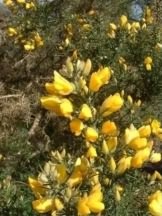
Photo ©2004–
Click photo for a larger image
Common Gorse - Ulex europaeus
Family - Fabaceae

Photo ©2004–
Click photo for a larger image
Gorse is an evergreen spiny shrub, native common and widespread in Britain, Ireland. Also found in Europe and North Africa. It is usually found on acid soils, heaths and commons, growing at quite a fast rate to 2m (6ft). Preferring dry sandy soils, it will grow in medium (loam) and heavy (clay) soils providing they are well–drained. It can grow in nutritionally poor soil, is drought and salt spray tolerant, preferring a full sun position. In leaf all year and flowering all year, the seeds also ripen all year, however a burst of flowers occur in the UK between February to May. Young leaves are trifoliate forming straight 15–25mm (0.6–1in) long grooved and very sharp spines. The small yellow flowers are hermaphroditic, smell of coconut, and are pollinated by bees. Gorse wood burns very well and with its preference for open heathland areas it can be a serious fire risk.
Introduced into the Americas in the early 19th century as a hedging plant to contain livestock and also for animal fodder, however by mid century localised populations of naturalised Gorse were evident, it is now classed a a damaging exotic weed. Similarly regarded in Australia and New Zealand. Planted for soil stabilisation in sandy areas with maritime exposure, it is fast growing, puts nitrogen back into the soil and provides conditions for woodland trees to become established. These trees will eventually out compete the gorse, which is unable to reproduce well in the shady conditions. Reproduction is mainly by seed, with each seed having a hard water resistant coat that prevents immediate germination, with seeds remaining dormant for up to 30 years. Seed dispersal is by ejection from the pod in warm weather when a distinctive "cracking" sound will be heard. The seed is quite heavy so it is not wind–dispersed, usually landing a short distance (2m 6ft) from the parent plant.
BCP do not advise or recommend that any part of the Gorse – Ulex europaeus is eaten or used as an herbal remedy. Flowers and shoot tips have been used to make tea and the flower buds can be pickled in vinegar and then used like capers in salads. Past medicinal uses include the treatment of jaundice and also as a treatment for scarlet fever. The flowers have been used to make a yellow dye and soaked seeds have an old reputation as a pesticide against fleas. It was voted the county flower of Belfast in 2002 following a poll by the wild flora conservation charity Plantlife.
Site design ©1999– Brickfields Country Park - Privacy -